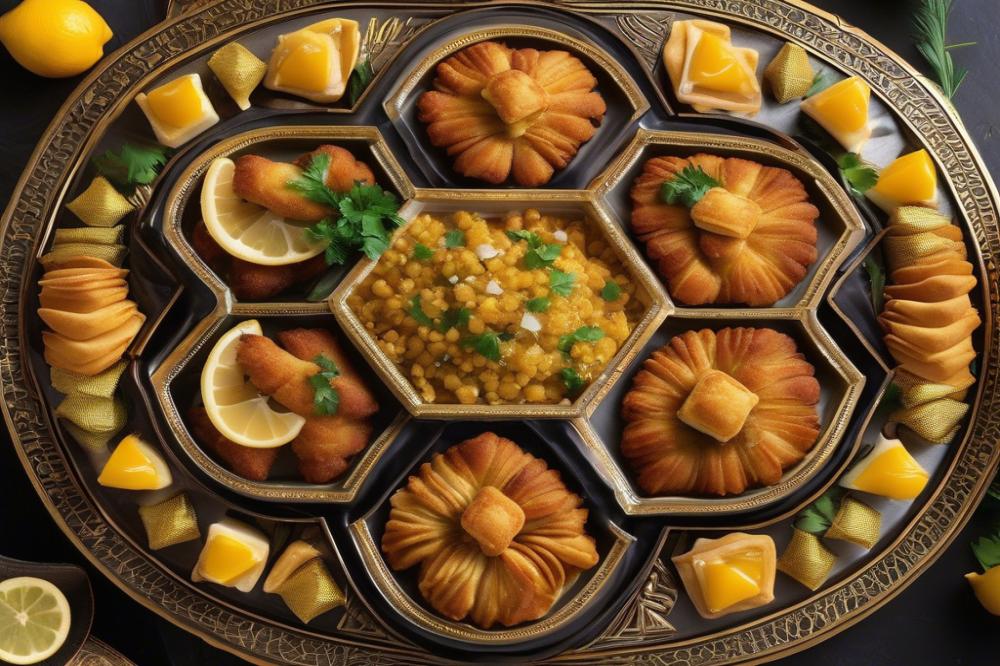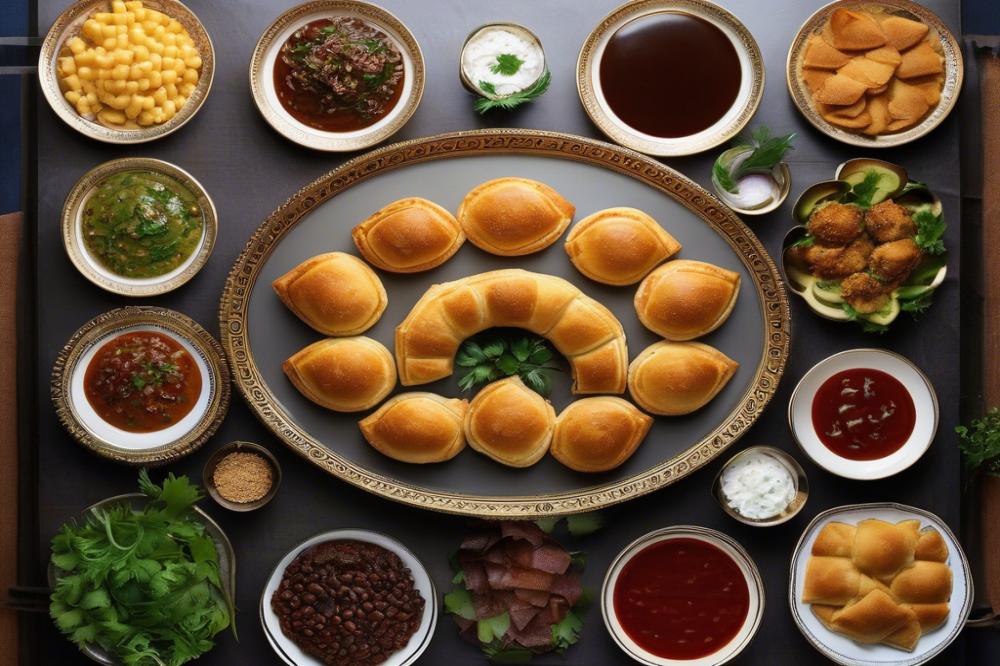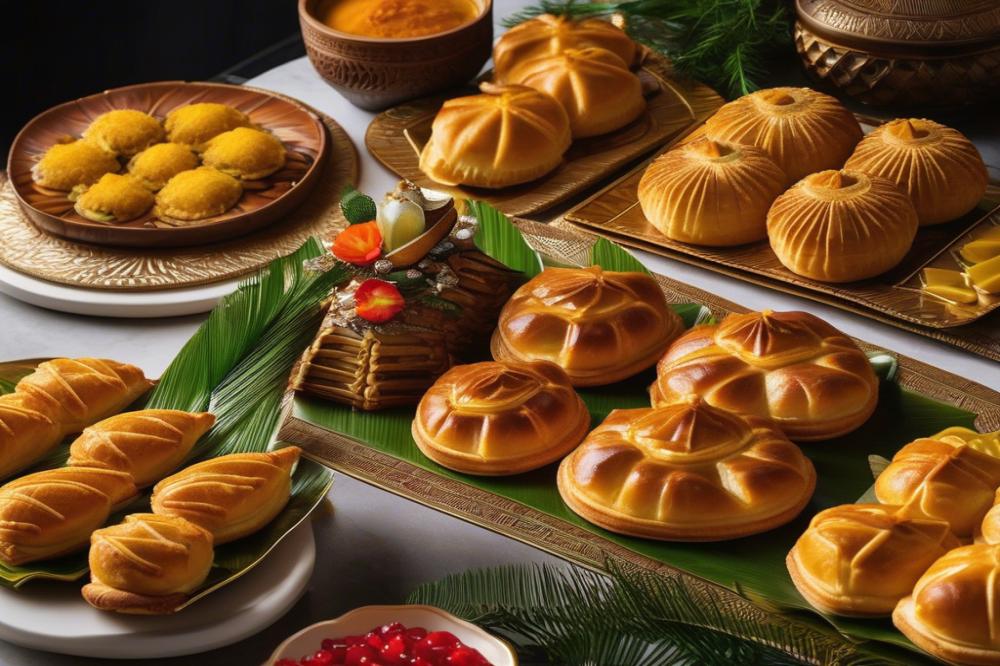Introduction
Egyptian Sambousek is a beloved dish known for its crispy exterior and savory filling. This pastry has cemented its place among the most popular appetizers in Egyptian cuisine. Traditionally, it is filled with seasoned ground meat, spices, and herbs. Sambousek is often served during gatherings, making it a staple snack during festive occasions in the Middle East.
The history of Sambousek reflects a rich cultural exchange. Its roots can be traced back to ancient culinary practices, evolving as different communities adapted the recipe over time. Various cooking techniques have emerged. Today, these meat-filled pastries are commonly enjoyed, whether fried to perfection or baked for a lighter option.
In Middle Eastern culture, Sambousek holds a special significance. It represents hospitality, often served to guests as a gesture of welcome. Snack time becomes an experience, where flavors take center stage. Variations exist across regions, showcasing local spices and ingredients. Each rendition adds depth to the overall history of this delectable dish.
As food enthusiasts explore the world of Egyptian cuisine, the Sambousek recipe stands out. It challenges cooks to blend textures and flavors. Mastering the craft of pastry dough while perfecting the filling is essential. From street vendors to gourmet kitchens, these pastries continue to inspire and delight.
The Basics of Egyptian Sambousek

Sambousek is a beloved dish within Egyptian cuisine. This pastry is often filled with various ingredients, making it a popular choice at gatherings. Ground meat is a common filling, often seasoned with a rich blend of spices. The name ‘sambousek’ refers to these delicious, savory pastries that resemble small turnovers or dumplings.
The pastry dough offers a tender, flaky texture, which is vital to the overall enjoyment of the dish. When prepared correctly, it crisps beautifully when fried, contributing to the delightful contrast with the juicy filling inside. A Sambousek recipe typically includes flour and water, creating a versatile dough that chefs can shape easily. It serves as a perfect outer layer, enhancing the experience of biting into a well-prepared pastry.
Seasonings play a crucial role in elevating the taste of sambousek. Spices such as cumin, coriander, and black pepper are commonly used to flavor the meat. Some variations incorporate herbs or pine nuts for added richness. This meticulous attention to flavor reflects the depth of Egyptian cooking techniques and shows how food history influences traditional dishes.
Sambousek is more than just a snack; it holds cultural significance in Egypt. During special occasions and celebrations, these pastries often take center stage as appetizers. Families gather to prepare sambousek together, sharing stories and laughter. This communal aspect brings people closer, making sambousek a staple in festive feasts and gatherings.
In summary, frying presents sambousek in a golden, appetizing finish. As Middle Eastern snacks go, these meat-filled delights certainly stand out. The combination of crispy pastry and flavorful filling makes each bite memorable. From everyday meals to grand celebrations, sambousek showcases the joy of Egyptian culinary traditions.
Ingredients List and Cooking Instructions

To create these delicious meat-filled pastries, you will need a selection of ingredients. Here’s what you need for the filling:
- Ground beef or lamb: 500 grams
- Onion: 1 medium, finely chopped
- Garlic: 2 cloves, minced
- Fresh parsley: 1/4 cup, chopped
- Spices: cumin, coriander, salt, and pepper to taste
- Olive oil: 2 tablespoons
- Pastry dough: sufficient for 20 pieces, either store-bought or homemade
These ingredients blend well, resulting in a flavorful filling for your sambousek. Now, let’s dive into the cooking instructions:
- Begin by preparing the filling. Heat the olive oil in a pan and sauté the chopped onions and minced garlic until they are translucent and aromatic.
- Next, add the ground meat. Cook it over medium heat until browned, breaking it apart as it cooks, so no large clumps remain.
- After the meat is browned, stir in the spices and parsley. Mix everything together well and then set aside the mixture to cool.
- Meanwhile, roll out your pastry dough on a clean surface. Use a round cutter or a drinking glass to cut out circles from the dough.
- Once you have your dough circles, fill each one with the cooled meat mixture. Be careful not to overfill them.
- Pinch the edges of the dough to seal each sambousek tightly. This prevents the filling from spilling out during frying.
- Heat oil in a deep pan or skillet for frying. Fry each sambousek in batches until they turn golden brown and crispy on the outside.
- After frying, drain them on paper towels. This removes excess oil and keeps them from becoming soggy.
Nutritional Information
Now let’s consider the nutritional profile of these delightful appetizers. Each serving of sambousek contains approximately:
- Calories: 250-300
- Protein: 15-20 grams
- Fat: 15-20 grams
- Carbohydrates: 30-35 grams
This sambousek recipe not only satisfies hunger but also offers a taste of Egyptian cuisine. When served, they appeal to those looking for Middle Eastern snacks with rich flavors. Mastering these cooking techniques can make them a staple in your appetizer lineup.
Cooking Techniques for Perfect Sambousek

Making sambousek begins with the pastry dough. A simple blend of flour, water, and a pinch of salt creates a versatile base. Knead the dough well for at least ten minutes. This process develops gluten, giving the dough its structure. Once it’s smooth, allow it to rest. Cover it with a damp cloth to keep it moist. Resting helps to relax the gluten, making it easier to roll out later.
Filling sambousek is an art. Opt for seasoned ground meat mixed with spices to enhance flavor. Common spices in Egyptian cuisine include cumin, coriander, and cinnamon. These spices elevate the taste profile, making it truly delightful. Place a spoonful of filling onto a rolled-out dough circle. Be careful not to overfill. A good rule of thumb is to keep the filling about a tablespoon.
Sealing sambousek properly is crucial for avoiding leaks during cooking. Fold the dough over the filling to create a semi-circle shape. Press the edges firmly together to prevent the filling from escaping. For added security, you can crimp the edges with a fork. This decorative touch also creates a tight seal.
When it comes to frying, the right oil temperature is key. Heat oil in a deep pan to around 350°F (175°C). This ensures a crispy exterior while keeping the insides juicy. Fry the sambousek in batches so they don’t crowd the pan. Crowding can lower the oil temperature and result in soggy pastries. Turn them occasionally for even browning, achieving that golden look.
For a healthier version, baking sambousek is an excellent alternative. Brush the pastries lightly with oil before placing them on a baking tray. Bake at 400°F (200°C) for about 20 minutes, or until they are golden brown. This method reduces the fat content while still providing a satisfying crunch. Serve them with a dipping sauce for added flavor. As a staple in Middle Eastern snacks, these appetizers are sure to impress friends and family alike.
Understanding the food history behind sambousek adds depth to its preparation. Each bite tells a story of culinary tradition and cultural fusion. With these cooking techniques, anyone can create their own version and enjoy the delicious result.
Exploring Variations of Sambousek

When it comes to sambousek, the fillings can vary greatly. While ground meat is the traditional choice, there are many other options to explore. Vegetarian varieties have gained popularity, offering delightful alternatives. Spiced potatoes, sautéed mushrooms, or a blend of herbs and cheese can fill the crispy pastry dough beautifully.
In different regions of Egypt, sambousek takes on unique characteristics. For instance, in Alexandria, it’s common to find seafood fillings, reflecting the coastal influences. Meanwhile, in Upper Egypt, local spices and ingredients often shape fillings. Traditional Egyptian cuisine is rich in flavors, making the pastry an excellent canvas for creativity.
Beyond the borders of Egypt, other Middle Eastern countries contribute their own variations. In Lebanon, sambousek can feature spiced lamb or even a medley of vegetables. Each version tells a story of the local culture and tastes. This diversity showcases how sambousek adapts to various palates.
Innovation also plays a role in modern sambousek recipes. Chefs are experimenting with fusion flavors, combining classic fillings with unexpected ingredients. Think of a sweet-and-savory option with figs and feta, or a spicy twist infused with jalapeños. Cooking techniques are also evolving, with baking emerging as a healthier alternative to traditional frying.
The history of sambousek adds layers to its appeal as a popular appetizer. Understanding its roots helps appreciate its adaptability. Today, families and restaurants alike are exploring fresh ideas, breathing new life into this beloved dish.
With endless possibilities, sambousek continues to delight as a Middle Eastern snack. Whether you follow a classic sambousek recipe or create your own, there’s no shortage of flavors to discover. The process of making these pastries can bring people together, fostering a shared love of food and tradition.
Serving Suggestions and Pairings
Dipping sauces play a vital role in enhancing the flavor of sambousek. Tahini sauce is a classic choice; its creamy texture complements the crispy pastry dough perfectly. A simple yogurt sauce with garlic and herbs also raises the dish’s freshness. Both options make for an excellent contrast to the spiced flavor of the ground meat filling.
When it comes to side dishes, consider serving a light salad. A simple cucumber and tomato salad, dressed with lemon juice, is refreshing. Another popular side is pickled vegetables, which add a tangy crunch that balances the richness of the pastries. Some families opt for rice dishes, often prepared with spices that mirror those used in the sambousek recipe.
Drinks can elevate the dining experience as well. Traditional options include hibiscus tea or mint lemonade. These drinks bring sweetness and a touch of acidity, pairing nicely with the savory taste of Middle Eastern snacks. For a modern twist, consider serving a crisp white wine or a sparkling drink.
In Egyptian households, sambousek is frequently part of the appetizer spread during gatherings. Families often lay out a variety of treats, inviting guests to enjoy a selection of flavors. Some people even serve sambousek as a main course, particularly during festive occasions.
Traditional cooking techniques for making sambousek emphasize the art of frying. The golden, crispy exterior is as much about skill as it is about ingredients. Modern adaptations sometimes involve baking to achieve a healthier option, but the authentic taste grows from the frying method. Each household may have its own version of filling, with spices varying by region.
Food history intertwines with cultural practices during times of celebration. Sambousek is often prepared ahead of time, allowing for easy reheating. Its popularity as a party food showcases its versatility, cherished across many generations. The ways in which one serves sambousek reflect the warmth and hospitality characteristic of Egyptian cuisine.
Embracing the Tradition of Sambousek
The rich history of meat-filled pastries has long been celebrated in Egyptian cuisine. Originating from the Middle East, sambousek has become a beloved dish, showcasing a delightful blend of flavors and cultural influences. Families often gather around the table during special occasions to share these pastries, making them a symbol of togetherness. The preparation of sambousek requires skill, patience, and love—qualities that reflect the importance of food in Egyptian culture.
Taking the time to try this sambousek recipe at home can be an enjoyable experience. Your kitchen can transform into a hub of creativity and warmth as the delicious aroma fills the air. Rolling dough and filling it with spiced meat allows for personalization and expression. No two platters are ever the same, offering a chance to create a dish that represents your own taste and style.
Sharing these pastries during gatherings creates memories that last a lifetime. The act of breaking bread with loved ones—a cultural practice across many societies—holds a special place in Egyptian hearts. Whether served as appetizers or in the midst of a grand feast, sambousek brings people closer together. As you embark on your culinary adventure, remember that food is not just about flavors; it’s about love, connection, and shared experiences.
So, gather your ingredients, invite friends or family to join you, and celebrate this time-honored tradition. Embrace the joy of cooking and sharing with others. In each bite of sambousek, you will find a taste of history, community, and the warmth of home.



